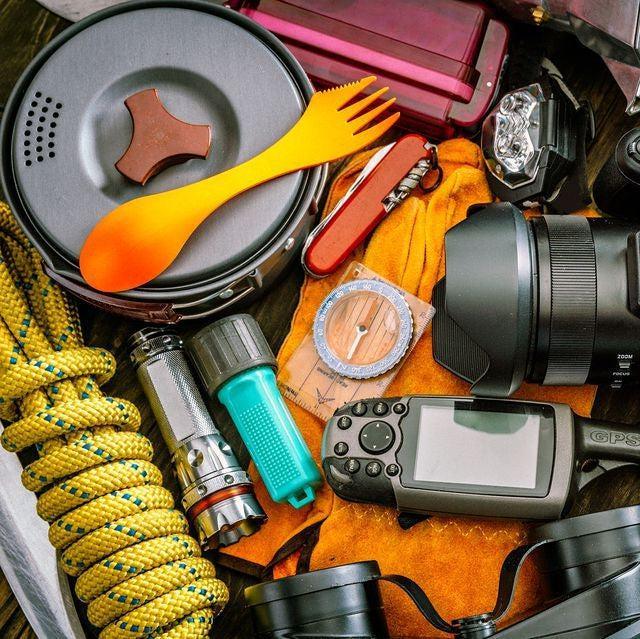
23 Overlooked Survival Foods You Need To Add To Your Pantry
Share
You might already have a good start on your survival pantry or stockpile. But you might also be overlooking some very easy items that would make great additions.
Sure, canned goods, dried beans, and water are a given. But that is where the list ends for some people.
If that describes you, then you are missing an opportunity to have a bigger variety of items and nutrition on hand for when you need it.
I have compiled a list of items often overlooked when creating an emergency pantry. These items all have the ability to add nutrition, calories, and variety to your survival. And, they have a long shelf life.
Rolled Oats
Oats are a wonderful source of fiber, protein, vitamin B6, and multiple minerals and antioxidants. In addition, oats are also easy to make and store.
If stored in an air-tight container, in a cool and dry location, rolled oats have a shelf life of about 30 years. With its nutrients, ease in cooking, and long shelf life, this makes a perfect item to have in abundance for your pantry.
Yeast

It’s great to have yeast in your pantry in order to make a variety of breads. If it’s stored in air-tight packages, it should last at least a couple years at room temperature.
It’s best to store the yeast in individual packets, so unused portions will remain air-tight and sealed.
You can either buy individual packets, or break a larger one down and vacuum seal the smaller portions individually.
Nutritionally, yeast is impressive. It contains protein, fiber, vitamin B’s, zinc, potassium, calcium, magnesium, and other minerals.
Dried Veggies
Canned fruit and veggies are OK to have on hand, sure. But, dehydrated veggies, just like fruits, have a great shelf life.
For example, dehydrated corn is good for 10 years, and carrots last up to 20 years. And, they tend to be more flavorful.
Lentils

Whole dried lentils have a shelf life of up to 5 years if stored in an air-tight container. So, that makes it a great choice to have in your pantry. But, they also are high in protein, an even better reason to consider them.
Jerky
When people think of jerky, it’s often beef or venison that comes to mind. But, many other proteins can be made into jerky, such as turkey, salmon, alligator, and even chicken. And, jerky is a quick source of protein on any given day.
You can buy it, or make your own. If you have a dehydrator, simply follow the directions to dehydrate your choice of protein.

Or, you can use the oven by slicing the protein, marinade it for up to 24 hours, dry the protein on a paper towel, and then hang the protein strips on the wire rack in the oven before the oven is preheated.
Make sure to have a drip pan below to catch anything that drips.
Preheat the oven anywhere from 170 to 200 degrees. Check the meat in 3 hours, but it could take up to 8 hours.
Quinoa
Quinoa has been found in many pantries since the ancient Incas. This grain alternative is full of nutrition containing 8 grams of protein and 8 essential amino acids in just 1 cup.
Make sure to store the (uncooked) quinoa in an air-tight container, and it will last at least 6 months.
Dried Fruit

Dates and raisins are just 2 examples of dried fruit to have on hand. They are easy to find and relatively inexpensive. But, you can turn many other fruits into dried fruit for the pantry. Fruits such as figs, cranberries, bananas, cherries, mango, plums, blueberries, apricots, and more can be easily dried in a dehydrator or oven.
Make sure to store these dried fruits in an air-tight container. If stored properly, they can survive on the shelf for up to 5 years.
Coconut Oil
Coconut oil is great to have on hand because of its high tolerance for heat while cooking, unlike butter and some other oils.
When not heated, it remains in a solid form and has a shelf life of at least 2 years if stored properly, in a dry and cool area.
Chickpeas

Chickpeas, or garbanzo beans, are a protein-rich food item that will add texture, flavor, and nutrients to a meal. And, if stored properly in an air-tight container, the shelf life is an impressive 30 years or more.
Honey
I’m not going to lie, this one surprised me. I don’t know how many jars of honey I have thrown out over the years, thinking it had gone bad because it was crystalized.
However, I now know that we shouldn’t throw out a perfectly good jar of honey, even if it’s crystalized. All you need to do is slightly warm it and stir and it will go back to its natural state.

Honey is a great addition to your pantry, not just because it tastes good and can be used to sweeten food and beverages.
It also has a lot of healthy attributes to it as well.
It can boost your energy, or soothe a sore throat and calm a cough.
Honey can also be used to help with wounds due to its natural antifungal and antibacterial properties, and will boost oxygen for healing wounds.
Look for 100% pure honey, and store it in an air-tight container. It will probably be used up long before it goes bad.
Nut Butters
You might have already considered peanut butter because it’s a common staple in most pantries. But, there are other nut butters you may want to consider.
Almond butter and sunflower seed butter are easy, quick, and healthy sources of nutrition and energy. You can find them in stores or make your own.
Properly closed jars of nut butters can last in the pantry for years.
Kamut

Kamut is a grain that is often overlooked. But since it’s easy to digest, and offers at least 40% more protein than wheat, it’s a great option.
It has the reputation of being a “high energy grain”, with its high level of lipid. The shelf life is consistent with other grains.
Pasta
Pasta is a good source of carbohydrates, which is necessary for a balanced diet. It’s lightweight for storage and can have good flavor with various seasonings.
Unopened dried pasta can last on the shelf for 2 years, while opened can still last a year. In addition, it’s an easy addition to soups and stews to make it more filling.
Nuts
I often turn to nuts when I’m in a short and temporary survival mode, such as being at an all-day event with little convenience for eating a meal.
And, I carry little bags of nuts in the car, in case of emergencies. So, this might not be an overlooked item for some, it might be for others who don’t love them as I do.

They have a lot of protein, are easy to store, and are easy to eat. Peanuts are relatively inexpensive when it comes to nuts.
But for a variety, other nuts to have on hand include pistachio, walnut, pine nut, corn nuts, cashew, macadamia, almonds, and hazelnut.
These all are good sources of protein, fiber, and necessary fat. Along with being a good source of protein, they are also rich in zinc, fluoride, selenium, iron, magnesium, potassium, and antioxidants.
If they are stored properly, in air-tight containers, they have a shelf life of 12 months.
Sugar & Salt
Sugar and salt don’t offer much in the nutritional area. Some would argue they do the opposite.
However, a little bit will go a long way in adding flavor to a meal, and that is also important because a lot of survival foods tend to be on the bland side without it.
Salt can also help preserve other foods, such as meats if you rub salt over it. When stored properly, sugar can last up to 2 years, and salt 5 years.
Maple Syrup

Maple syrup can add a lot of flavor to foods, and replace sugar as a sweetener. And, it has more calcium than milk, as well as zinc, potassium, and iron.
The perk of maple syrup is that you can forage it from a maple tree yourself if you have them in your area.
An unopened bottle of store-bought maple syrup will last about a year. An opened bottle should be kept in a refrigerator if possible.
Alcohol
Alcohol is often overlooked as a survival item. But it has far more perks to it other than just having a drink. It can be used as fuel when using a compact alcohol stove. It also works as a disinfectant for wounds or tools.
To improve the shelf life of fruit, soak it in alcohol, such as vodka, rum, or whiskey. An unopened bottle will last forever. Once it’s opened, it still has up to 2 years on the shelf without going bad. And even then, when it comes to alcohol “bad” typically means losing some color and flavor.
Potato Flakes

Instant potatoes are a great addition to your survival pantry. They are very easy to make, and the flavor can be altered for variety.
Eat them as intended, change them into a soup, or use them as a thickener for other dishes. You can also turn the flakes into flour for making bread.
Unopened packages of instant potatoes will last on the shelf for up to 15 years when stored properly in air-tight containers. Once opened, the shelf life is between 6 months to a year.
Nonfat Dry Milk & Powdered Milk
Nonfat dry milk has a very long shelf life of 20 years. Unfortunately, it doesn’t taste all that great. But, the nutritional value makes up for the lack of flavor. It has a nice balance of fiber, carbohydrates, sodium, and potassium.
On the other hand, powdered milk has a much better taste, and is also nutritious. It is rich in vitamin C & A, iron, zinc, and calcium. The downside to powdered milk though is the shelf life is much shorter at 2 years for an unopened package.
Apple Cider Vinegar

In addition to having a very long shelf life, apple cider vinegar has many health benefits as well.
Its antioxidants can help with fending off viruses, improve gut health, soothe an irritating cough, and rumor has it that it might aid in lowering cholesterol.
Cornmeal
Cornmeal can be used in place of flour. But, you can also use it to make corn tortillas, without needing yeast. Some people also use it to thicken soups and dishes and add a corn flavor.
Cornstarch
I’m adding cornstarch to the list because it will last forever, and can be more than just a thickener. It can also be used to clean, deodorize, repel insects, and soothe an irritating rash.
Powdered Drink Mixes
Powdered lemonade and other powdered fruit drink mix not only can sit on a shelf for years, but they also can add a variety when it comes to keeping yourself hydrated. And, many of them have vitamin C added.
The above list consists of items that are common in most kitchen pantries. But, you might not have considered their value when thinking of your survival pantry. Hopefully, this will help you in adding variety, nutrition, and longevity to your stockpile!



2 comments
I have been reading up on survival since I was a child I already knew everything in you article, thanks for the reminder,it’s always good to review things so we don’t forget GOD bless you, your family, friends, co-workers and everyone who ever ready any of your posts
I have been reading up on survival since I was a child I already knew everything in you article, thanks for the reminder,it’s always good to review things so we don’t forget